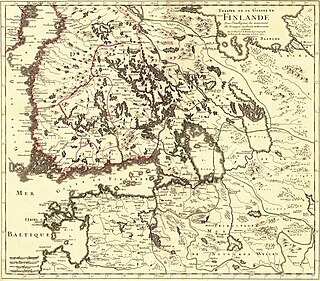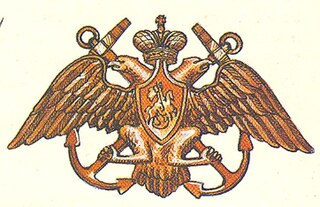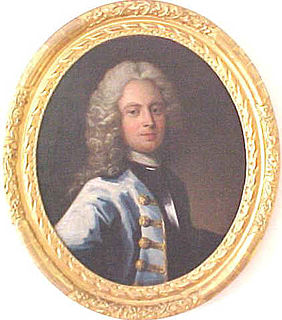Related Research Articles

The Great Northern War (1700–1721) was a conflict in which a coalition led by the Tsardom of Russia successfully contested the supremacy of the Swedish Empire in Northern, Central and Eastern Europe. The initial leaders of the anti-Swedish alliance were Peter I of Russia, Frederick IV of Denmark–Norway and Augustus II the Strong of Saxony–Poland–Lithuania. Frederick IV and Augustus II were defeated by Sweden, under Charles XII, and forced out of the alliance in 1700 and 1706 respectively, but rejoined it in 1709 after the defeat of Charles XII at the Battle of Poltava. George I of Great Britain and the Electorate of Hanover joined the coalition in 1714 for Hanover and in 1717 for Britain, and Frederick William I of Brandenburg-Prussia joined it in 1715.

The Russo-Swedish War of 1741–1743 was instigated by the Hats, a Swedish political party that aspired to regain the territories lost to Russia during the Great Northern War, and by French diplomacy, which sought to divert Russia's attention from supporting its long-standing ally the Habsburg monarchy in the War of the Austrian Succession. The war was a disaster for Sweden, which lost more territory to Russia.

The Russo-Swedish War of 1788–1790 was fought between Sweden and Russia from June 1788 to August 1790. The war was ended by the Treaty of Värälä on 14 August 1790 and took place concomitantly with both the Austro-Turkish War (1788–1791), Russo-Turkish War (1787–1792) and Theatre War. The war was, overall, mostly insignificant for the parties involved.

Kronstadt, also spelled Kronshtadt, Cronstadt or Kronštádt is a Russian port city in Kronshtadtsky District of the federal city of Saint Petersburg, located on Kotlin Island, 30 kilometres (19 mi) west of Saint Petersburg, near the head of the Gulf of Finland. It is linked to the former Russian capital by a combination levee-causeway-seagate, the St Petersburg Dam, part of the city's flood defences, which also acts as road access to Kotlin island from the mainland.

Fyodor Fyodorovich Ushakov was an 18th century Russian naval commander and admiral. He is notable for winning every engagement he participated in as the Admiral of the Russian fleet.

During the Napoleonic Wars, the Anglo-Russian War was the phase of hostilities between Great Britain and Russia after the latter signed the Treaty of Tilsit that ended its war with France. Anglo-Russian hostilities were limited primarily to minor naval actions in the Baltic Sea and Barents Sea.

The Imperial Russian Navy operated as the navy of the Russian Tsardom and later the Russian Empire from 1696 to 1917. Formally established in 1696, it lasted until dissolved in the wake of the February Revolution of 1917. It developed from a smaller force that had existed prior to Tsar Peter the Great's founding of the modern Russian navy during the Second Azov campaign in 1696. It expanded in the second half of the 18th century and reached its peak strength by the early part of the 19th century, behind only the British and French fleets in terms of size.

Lodewijk Sigismund Vincent Gustaaf Reichsgraf van Heiden was a Dutch admiral who commanded a squadron of the Imperial Russian Navy in the Battle of Navarino (1827).

The Battle of Gangut took place on 27 JulyJul./ 7 August 1714Greg. during the Great Northern War (1700–1721), in the waters of Riilahti Bay, north of the Hanko Peninsula, near the site of the modern-day city of Hanko, Finland, between the Swedish Navy and Imperial Russian Navy. It was the first important victory of the Russian fleet in its history.

Dmitry Nikolayevich Senyavin or Seniavin was a Russian admiral who ranks among the greatest seamen of the Napoleonic Wars.

Ivan Stepanovich Isakov (Armenian: Հովհաննես Իսակով, Russian: Иван Степанович Исаков;, born Hovhannes Ter-Isahakyan, was a Soviet Armenian military commander, Chief of Staff of the Soviet Navy, Deputy USSR Navy Minister, and held the rank of Admiral of the Fleet of the Soviet Union. He played a crucial role in shaping the Soviet Navy, particularly the Baltic and Black Sea flotillas during the Second World War. Aside from his military career, Isakov became a member and writer of the oceanographic committee of the Soviet Union Academy of Sciences in 1958 and in 1967, became an honorary member of the Armenian Soviet Socialist Republic's Academy of Sciences.

The Battle of Viborg Bay was a naval battle fought between Russia and Sweden on July 4, 1790, during the Russo-Swedish War (1788–1790). The Swedish Navy suffered heavy losses, losing six ships of the line and four frigates, but Gustav III of Sweden eventually ensured a Swedish naval escape through a Russian naval blockade composed of units of the Baltic Fleet, commanded by Admiral Vasili Chichagov. The battle ranks among the world's largest historical naval battles and also among the most influential, as it introduced the naval battle concept of "firepower over mobility".

The Battle of Grengam, Finnish: Flisön taistelu of 1720 was the last major naval battle in the Great Northern War that took place in Åland, in the Ledsund strait between the island communities of Föglö and Lemland. The battle marked the end of Russian and Swedish offensive naval operations in Baltic waters. The Russian fleet conducted one more raid on the Swedish coast in spring 1721, whereupon the Treaty of Nystad was signed, ending the war.

Jean Baptiste Prevost de Sansac, marquis de Traversay was a naval officer of French creole origins who distinguished himself in the ranks of Royal French Navy during the American Revolutionary War. In 1791, fleeing from the French Revolution, Traversay joined the Imperial Russian Navy, rising to commander-in-chief of the Black Sea Fleet in 1802. In 1809 he was appointed Minister of the Navy, which position he held for 18 years. His name was frequently russified to Ivan Ivanovich de Traversay.

A hemmema was a type of warship built for the Swedish archipelago fleet and the Russian Baltic Fleet in the late 18th and early 19th centuries. The hemmema was initially developed for use against the Imperial Russian Navy in the Archipelago Sea and along the coasts of Svealand and Finland. It was designed by the prolific and innovative Swedish naval architect Fredrik Henrik af Chapman (1721–1808) in collaboration with Augustin Ehrensvärd (1710–1772), an artillery officer and later commander of the Swedish archipelago fleet. The hemmema was a specialized vessel for use in the shallow waters and narrow passages that surround the thousands of islands and islets extending from the Swedish capital of Stockholm into the Gulf of Finland.

The siege of Viborg took place in the spring of 1710 during the Great Northern War (1700–1721), as a second attempt by the Russians to capture the fortress port of Viborg (Vyborg), near the modern border between Russia and Finland, after a failed attempt in 1706. After the outbreak of the war, Swedish forces had fortified themselves in the port of Viborg. In order to assure safety for the newly founded city of Saint Petersburg, Peter the Great ordered the Swedish fort to be secured. A first unsuccessful attempt was made in 1706. Later plans were put on hold because of other ongoing conflicts but, after the Russian success at the Battle of Poltava in June 1709, the men and resources were available to capture the town.

Gustaf von Psilander was an admiral of the Royal Swedish Navy. In 1704, Psilander fought his most famous action in the Battle of Orford Ness against a superior English force where he was defeated, the battle coming about as a result of his refusal to salute them under strict orders from his king.
Yuri Aleksandrovich Panteleyev was an officer of the Soviet Navy. He rose to the rank of admiral and was commander of the Pacific Fleet.

Captain John Deane was an English sailor with a long career in the Royal Navy and Russian Navy. He rose to the rank of captain in the Royal Navy, commanding in the Capture of Gibraltar. Deane later commanded a trading vessel, the Nottingham Galley, shipwrecked on Boon Island in 1710. Deane spent 1714–1721 in service with the Tsar Peter the Great commanding a Russian naval ship. He then worked in Flanders as British Consul to the Port of Ostend until 1740, when he retired to his native Wilford, Nottingham. He died in 1761 from injuries in a violent assault. His wife died on the next day.

Already in the 9th century, Kievan Rus' had the powerful naval fleet which is proved by the successful naval Siege of Constantinople of 860 However the naval fleet was irregular and was built only for the purpose of raids. Due to several major weakness of the naval fleet and in addition destructive invasion by the Mongol Empire, later the irregular naval fleet of the Kievan Rus principalities was dissolved. Except for the Principality of Novgorod which had access to the open seas and also was saved from Mongol invasions. In the 14th century, raids by Novgorod pirates, or ushkuiniki, sowed fear as far as Kazan and Astrakhan. As the first and proper Russian state of the Grand Duchy of Moscow begun and also got access to open water bodies, the Golden Age of the Russian Navy began. In 1570, in order to protect Russian navigation at the Baltic Sea, Ivan the Terrible created a flotilla which existed for about a year. In the 16th century, the Tsardom of Russia fought against the Ottoman Empire to get free access to the Black Sea.
References
- 1 2 3 4 5 (in Russian) Боцис, граф Иван Федосеевич at biografija.ru
- 1 2 3 (in Russian) Боцис, Иван Федосеевич